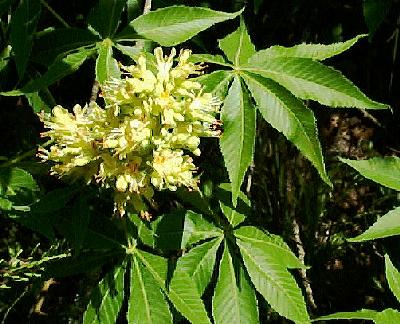Genus Actinidia
The terminal half of its green leaves are cream tinged with pink. This variegation seems to be better on male plants and in sun. There is no variegation on young plants. In early summer, lightly scented, white flowers are produced. These are followed by the sweet, yellow fruits.
Pot Cultivation
A chinensis can only be grown in mild climates. It will survive in climates where temperatures do not fall below 10º to 15º F. The Kiwi does, however, need a period of winter chill to break dormancy; the temperature must fall below 50º F for at least 30 days or more. If you garden in a region that doesn't fall below that temperature, there are low-chill hybrids available. A. arguta and A. kolomikta are the hardy Kiwi fruits. They can withstand temperatures as low as -25º F. Their fruits need about 5 months to ripen. A. arguta is quick growing and will have to be pruned often to keep it in control. A. kolomikta is less vigorous and hardier than A. arguta and only needs 19 weeks to ripen its fruits. Kiwis are usually sold as one-year-old vines, in the spring. They need well-drained soil with a pH of 5.0 to 6.5. Ordinary garden soil that has been deeply dug and enhanced with decayed manure and a little leaf mold and peat is best. A. chinensis and A. arguta do best in full sun, although they will tolerate partial shade, especially in hot climates. A. kolomikta prefers light shade. To obtain fruits, plants of both sexes must be planted.To keep these vines in control, but still producing fruit, it is better to prune only once a year while the vine is dormant. Trim back all branches that have borne fruits and any long non-fruiting shoots to about 18 inches from the branching point. If the vine is really out of control, you can cut it back severely to return it to its original boundaries. For a neater plant that produces fewer, but larger fruits, you can train it as you would train grapes. Support the plant on a strong trellis or arbor anchored by 4-inch square posts. When you plant the vine, prune it back to four or five buds, which will grow into shoots. Choose the strongest shoot to be the main trunk and tie it to the arbor, cut it off at the tip to induce new side branches to grow along the arbor. Once a month, throughout every summer, each new shoot will have to be cut back to four or five buds. This process will produce a compact, short-limbed vine, which will produce an abundance of fruits in its second or third year. The kiwi fruits are produced near the base of the current year's new shoots. A chinensis is ready for harvest when the skin turns brown and the seeds black (one can be cut open to check). Ripe hardy kiwis will either drop on their own, or will twist off easily in the hand. Pick them with their stems attached. Kiwis are quite pest-resistant. Japanese beetles can be troublesome, but don't cause major damage. To control them, simply knock them off one by one into a small container of ammonia or soapy water. Kiwis can die from crown rot if they are planted in heavy, waterlogged soil. This can be prevented by planting in a well-drained location.
Propagation
Cuttings may be taken of semi-woody shoots of the current year's growth. These are inserted in a frame or under a hand light in a sheltered border. The ends of trailing branches can also be layered. Seeds can also be planted in sandy soil in a greenhouse.
A. chinensis

A. arguta
VARIETIES
- A. chinensis (Chinese Gooseberry, Kiwi Berry, Yang-Tao) & var. Abbott, Blake, CC Early, California, Gracie, Hayward, Vincent. A. kolomikta & var. Arctic Beauty, Clara Zetlan, Krupnopladnaya.
- A. arguta (Arctic Kiwi, Bower Actinidia, Hardy Kiwi, Siberian Gooseberry, Tara Vine, Yang-Tao) & var. Ananasnaja (Manchurian Pineapple, Anna Kiwi, Ana, Anna), Dumbarton Oaks, Issai, Meader




